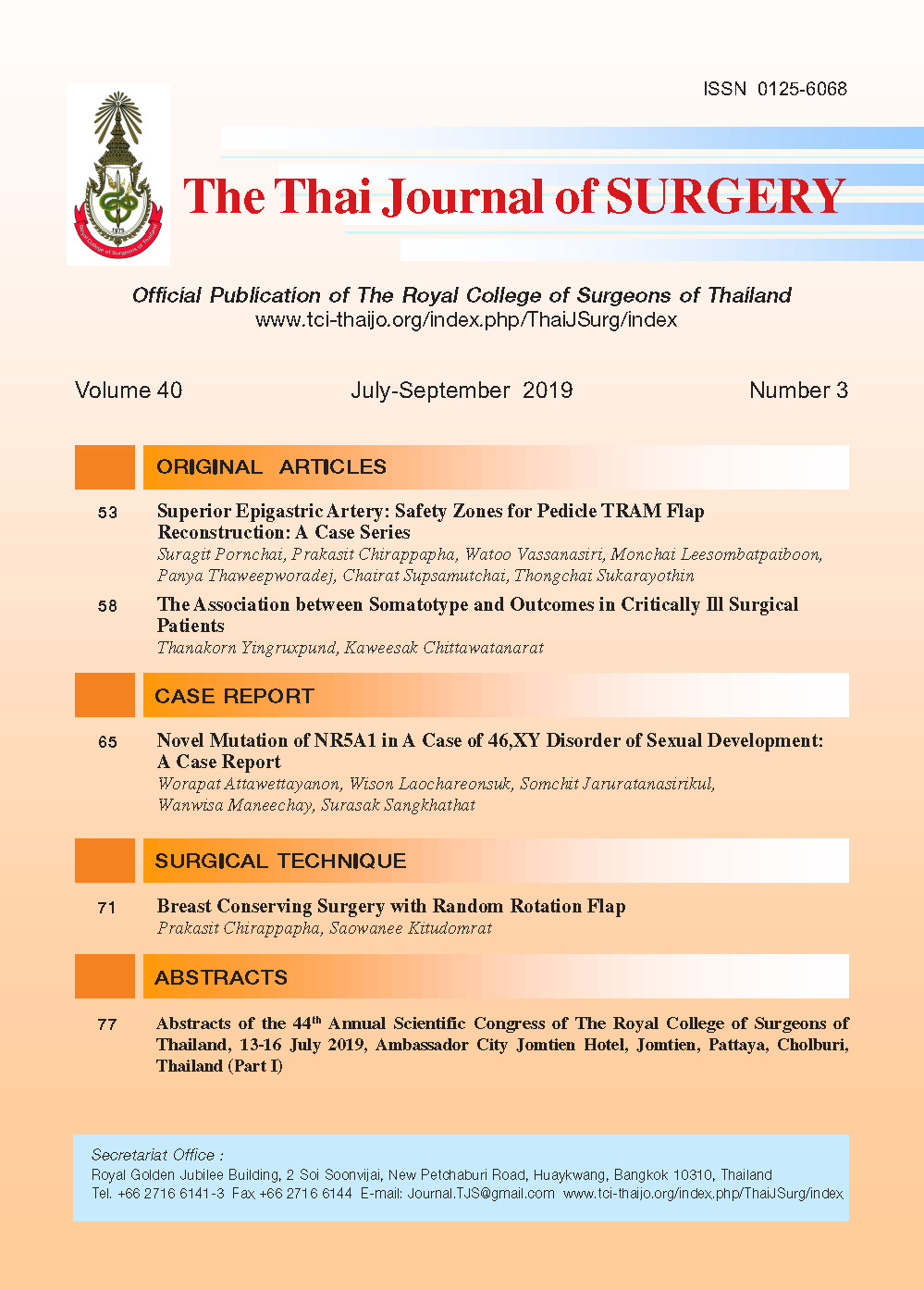The Association between Somatotype and Outcomes in Critically Ill Surgical Patients
Keywords:
Somatotype, Endomorphy, Ectomorphy, Surgical intensive care unitAbstract
Background: The somatotype is defined as the quantification of the present shape and composition of the human body. It can be simply categorized into 4 groups (Endomorphy, mesomorphy, ectomorphy and central group). Some studies show that mesomorphic component positively correlate to lean body mass which is acceptable proved that loss of lean body mass more than 25-30 % results in fatal outcomes in critically ill surgical patients. Because there is no study that prove the association between somatotype and outcomes in critically ill surgical patients. Therefore, the purpose of this study was to prove the association of the somatotype and the outcomes in critically ill surgical patients.
Patients and Methods: A total of 200 critically ill surgical patients in surgical intensive care unit at Maharaj Nakorn Chiang Mai hospital were collected. Demographic data and outcomes (28-day mortality rate, Hospital length of stay, ICU length of stay and duration of ventilator use) were compared among 4 groups of somatotypes (endomorphy, mesomorphy, ectomorphy and central group)
Results: There was no significant difference in outcomes of critically ill surgical patients between 4 groups of somatotypes (endomorphy, mesomorphy, ectomorphy and central group). The 28-day mortality rate are 0%, 16.7%, 14.9%, 8.6% (p = 0.15) in endomorphy, mesomorphy, ectomorphy and central group respectively. The median length of hospital stay was 15, 19, 31, 20 days (p = 0.21) respectively. The median length of ICU stay was 14, 7, 12, 8 days (p = 0.36) respectively. The median duration of ventilator use was 12, 5, 12, 7 days (p = 0.38) respectively.
Conclusion: This study shows that no significant difference in outcomes of critically ill surgical patients between 4 groups of somatotypes. 28-day mortality rate, length of hospital stay, length of ICU stays and duration of ventilator use.
References
2. Vestbo J, Prescott E, Almdal T, et al. Body mass, fat-free body mass, and prognosis in patients with chronic obstructive pulmonary disease from a random population sample: findings from the Copenhagen City Heart Study. Am J Respir Crit Care Med 2006;173:79-83.
3. Bolonchuk WW, Hall CB, Lukaski HC, Siders WA. Relationship between body composition and the components of somatotype. Am J Hum Biol 1989;1:239-48.
4. Savalle M, Gillaizeau F, Maruani G, et al. Assessment of body cell mass at bedside in critically ill patients. Am J Physiol Endocrinol Metab 2012;303:E389-96.
5. Bulbulian R. The influence of somatotype on anthropometric prediction of body composition in young women. Med Sci Sports Exerc 1984;16:389-97.
6. Slaughter MH, Lohman TG. Relationship of body composition to somatotype. Am J Phys Anthropol 1976;44:237-44.
7. Slaughter MH, Lohman TG, Boileau RA. Relationship of Heath and Carter's second component to lean body mass and height in college women. Res Q 1977;48:759-68.
8. Chittawatanarat K, Chaiwat O, Morakul S, et al. A multi-center Thai university - based surgical intensive care units study (THAI-SICU study): Methodology and ICU characteristics. J Med Assoc Thai 2014;97 S45-S54.
9. Chittawatanarat K. Anthropometric measurement in clinical applications: height, body weight and body composition prediction [Clinical epidemiology]. Chiang Mai: Chiang Mai University; 2012.
Downloads
Published
How to Cite
Issue
Section
License
Articles must be contributed solely to The Thai Journal of Surgery and when published become the property of the Royal College of Surgeons of Thailand. The Royal College of Surgeons of Thailand reserves copyright on all published materials and such materials may not be reproduced in any form without the written permission.


